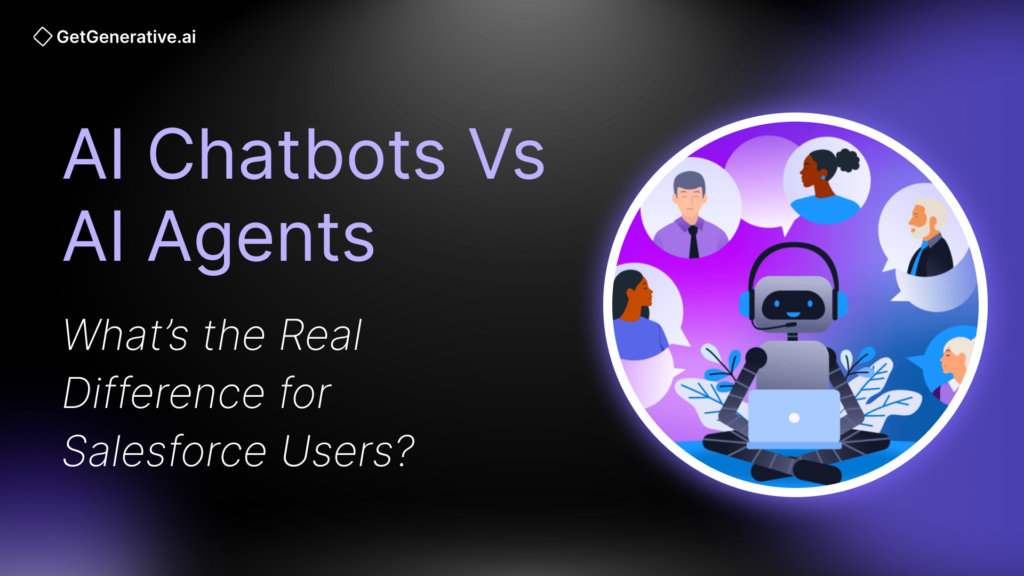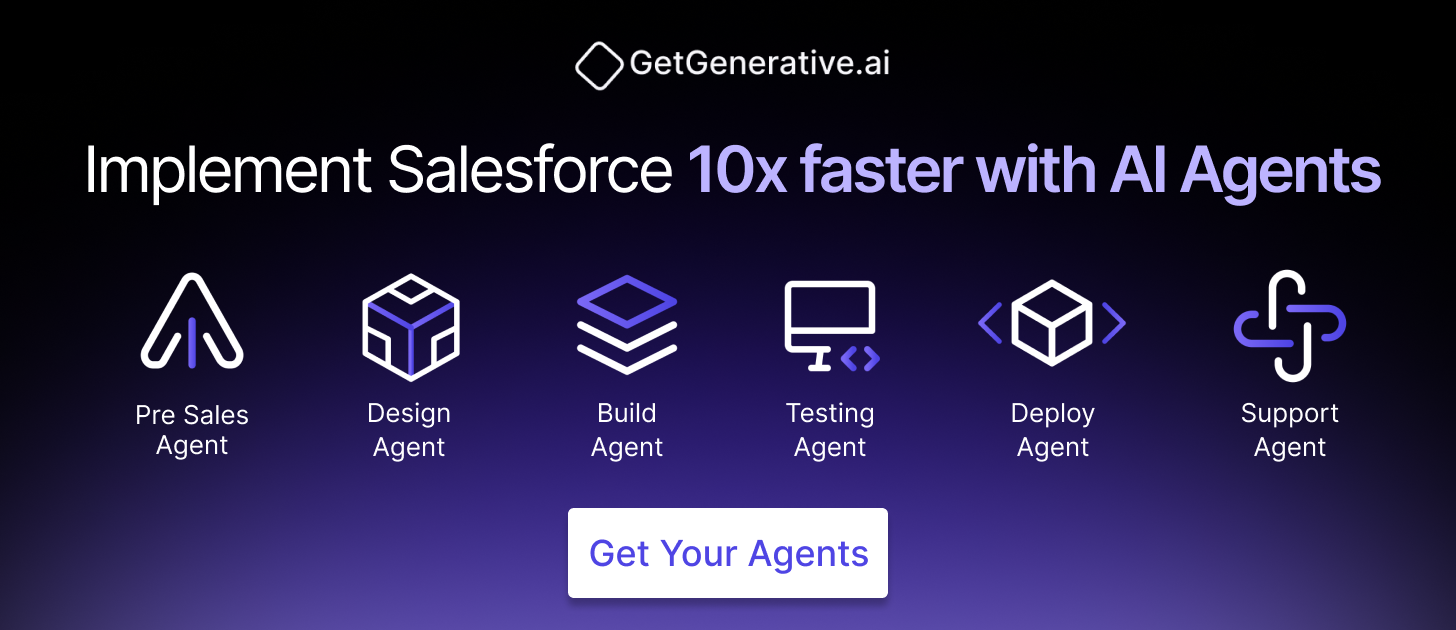AI Chatbots vs AI Agents: What’s the Real Difference for Salesforce Users?
In the Salesforce ecosystem, AI-powered assistants are rapidly evolving. Traditional chatbots have long helped companies handle FAQs or basic service requests using scripts or limited NLP. But now, AI agents—powered by large language models (LLMs)—are transforming how businesses interact with customers, automate workflows, and execute decisions.
As Salesforce doubles down on generative AI across its platforms—Sales Cloud, Service Cloud, Marketing Cloud, and Slack—understanding the difference between a chatbot and an AI agent isn’t just technical—it’s strategic. This guide breaks down the core differences, real-world use cases, and more. Let’s dive in!
The Rise of AI in Salesforce CRM
Salesforce has been embedding AI into its platform for years, starting with predictive tools like Einstein Lead Scoring and Einstein Bots for service automation. But with the release of Einstein GPT in 2023, Salesforce introduced generative AI capabilities, radically expanding what AI can do inside the CRM.
Powered by integrations with LLMs like OpenAI and Anthropic, Einstein GPT connects to Data Cloud (Salesforce’s customer data platform) to personalize output, automate workflows, and deliver real-time insights. In parallel, Salesforce-owned Slack is evolving into a conversational work platform with Slack GPT and Einstein Copilot, enabling users to “talk to their CRM” via natural language.
Key stats that highlight the shift:
- Nearly 50% of service professionals worry they’ll fall behind without adopting generative AI (Salesforce Research, 2024).
- Only 24% are currently using generative AI, but 90% of those report faster issue resolution.
- Over 65% of generative AI users (primarily Millennials and Gen Z) feel confident using AI in daily workflows.
For Salesforce leaders, the question isn’t if to adopt AI, but how to use it: traditional rule-based bots, dynamic AI agents, or a hybrid of both?
What Is an AI Chatbot in Salesforce?
Chatbots in Salesforce are typically rule-based conversational tools built to automate repetitive, predictable interactions. They operate within predefined flows and rely on keywords or simple NLP to guide users.
Examples:
- Einstein Bots in Service Cloud: Handle self-service tasks like order tracking, password resets, or case creation.
- Website chat widgets: Built using Salesforce Live Agent or Experience Cloud, often used to triage inquiries or capture leads.
Benefits:
- Cost-effective at scale (e.g., 7,000+ cases deflected in 6 months with Einstein Bot—198% ROI, Salesforce case study).
- Deliver consistent answers for high-volume FAQs.
- Integrate with CRM data to capture records or prequalify issues before escalation.
Limitations:
- Limited understanding of complex or ambiguous queries.
- Require extensive configuration (scripts, training data, utterances).
- Not generative—can’t create new content or reason beyond scripts.
Common Salesforce Chatbot Use Cases:
Use Case | Example |
Customer support | Order status checks, appointment rescheduling |
HR or IT help desk | FAQ resolution, ticket routing |
Marketing automation | Lead qualification, contact info capture |
What Is an AI Agent in Salesforce?
AI agents represent a significant leap in intelligence and autonomy. Built on LLMs and Salesforce data, they go beyond conversation—they think, generate, and act. Rather than waiting for user input, they can proactively assist, learn from context, and execute end-to-end workflows.
Core Capabilities:
- LLM-powered generation: Understand open-ended queries like “What accounts are at risk this quarter?” and generate human-like responses.
- Actionability: Update records, send emails, trigger flows—autonomously.
- Learning and adaptability: Learn from past interactions and refine future responses.
- Contextual grounding: Use structured (CRM) and unstructured (emails, chats) data to personalize output in real time.
Salesforce AI Agent Offerings:
Tool | Description |
Einstein GPT | Generative AI built into every Salesforce cloud; creates emails, service replies, campaign content |
Einstein Copilot (Slack GPT) | Conversational Slack interface that pulls live CRM data into chat |
Agentforce | Platform to build autonomous agents (Sales, Service, Marketing) using low-code tools |
Third-Party Agents | Integrations via AppExchange with tools like Claude, Cohere, or GetGenerative.ai |
Use Cases:
- Drafting sales playbooks, outreach sequences, or customer communications.
- Summarizing support case history and recommending next steps.
- Automatically escalating customer issues when complaint patterns emerge.
- Guiding employees through step-by-step HR or finance tasks.
Also Read – What are Different Types of AI Agents?
AI Chatbots vs AI Agents: Core Differences
Feature | Chatbots | AI Agents |
Technology | Rule-based scripts + basic NLP | LLMs + structured/unstructured CRM data |
Scope | Limited to predefined flows | Flexible, multi-step reasoning |
Learning | Static—no self-learning | Adaptive—learns from interactions |
Output | Scripted responses | Generated content (e.g., emails, plans) |
Actions | Points to resources | Triggers actions (record updates, emails) |
Deployment | Longer due to scripting needs | Faster using pre-trained models |
Best suited for | High-volume, predictable tasks | High-value, dynamic decision-making |
Actions | Points to resources | Triggers actions (record updates, emails) |
Deployment | Longer due to scripting needs | Faster using pre-trained models |
Best suited for | High-volume, predictable tasks | High-value, dynamic decision-making |
As Salesforce itself describes: “Chatbots are like vending machines. AI agents are like personal assistants that anticipate your needs and get work done.”
Salesforce AI: From Einstein Bots to Agentforce
Salesforce offers a continuum of AI tools, each suited for different use cases.
1. Einstein Bots
- Ideal for scripted FAQ and triage tasks
- Configurable via point-and-click flows
- Cost-effective, especially for customer-facing service scenarios
2. Einstein GPT
- Powers generative tasks like writing service replies, sales emails, or marketing content
- Works across Sales, Service, and Marketing Clouds
- Secure via the Einstein Trust Layer, ensuring zero prompt retention or data leakage
3. Slack GPT / Einstein Copilot
- Brings natural language CRM interaction into Slack
- Examples: “/einstein summarize open cases” or “Create a close plan for Acme deal”
4. Agentforce
- Lets users build custom agents (Sales Coach, Service Agent) with low-code tools
- Leverages Atlas Reasoning Engine for multi-step understanding
- Agents can operate autonomously and proactively (e.g. remind of contract renewals, suggest next-best-action)
5. Integration Ecosystem
- Agents connect to Salesforce APIs, Flows, MuleSoft, and third-party tools
- Available via console widgets, Slack apps, or embedded in mobile apps
Real-World Use Cases
Let’s break down how companies are actually deploying these technologies—and what they’re getting in return.
1. Einstein Bots for Service Deflection
- A travel company implemented Einstein Bots and deflected over 7,000 cases in just 6 months, resulting in a 198% ROI.
- Tasks automated: reservation updates, policy info, appointment rescheduling.
- Outcome: fewer human-agent escalations, higher customer satisfaction.
2. OpenTable with Agentforce
- OpenTable, managing 60,000+ restaurants, deployed Agentforce to respond to loyalty questions like “When do my points expire?” or “Do points work in Mexico?”
- Agents maintained context across follow-ups and personalized replies at scale.
- Outcome: Freed up support staff for complex issues and improved resolution speed.
3. Salesforce Using Einstein GPT Internally
- Salesforce’s own teams use Einstein GPT to draft prospect emails, outreach plans, and internal documents.
- Example: sales reps use Copilot to generate personalized messaging at scale.
- Outcome: accelerated deal cycles and reduced time spent on admin tasks.
4. SharkNinja + Agentforce
- SharkNinja, a global appliance brand, deployed agents for 24/7 order updates, troubleshooting, and follow-ups.
- Projected outcome: 65% self-service rate with minimal human intervention.
5. Adobe Population Health
- Used Agentforce to automate routine workflows in healthcare, saving ~$800,000 annually.
- Example: appointment reminders, health document delivery, care follow-ups.
- Outcome: dramatically improved cost efficiency and patient experience.
6. Education Sector
- Nonprofit used generative agents to support students 24/7 through peer coaches.
- Student support capacity increased by 4x, while maintaining quality.
- Outcome: Scalability without sacrificing personal touch.
Strategic Insights & Recommendations
1. Map Use Cases Thoughtfully
- Use chatbots for well-defined, high-volume tasks like FAQs or onboarding.
- Use agents for dynamic, high-value workflows like sales outreach or issue resolution.
- Start small. Salesforce recommends beginning with low-risk, high-impact pilots (e.g., internal support or sales enablement).
2. Tap into Salesforce’s Trust Layer
- Salesforce’s Einstein Trust Layer ensures secure AI interactions: prompts are not retained, sensitive fields can be masked, and results are audited.
- This enterprise-grade trust is essential, especially in regulated industries like healthcare and finance.
3. Measure What Matters
- Define KPIs before launch:
- Chatbots: case deflection rate, bot containment rate, resolution time
- Agents: hours saved, revenue influenced, CSAT improvements
- Use Einstein dashboards to track ROI. Promote early wins to accelerate internal adoption.
4. Train Your Teams
- Surveys show many users still lack confidence using AI.
- Create AI onboarding playbooks, role-based training, and internal champions.
- Highlight stats: 90% of users say AI helps them work faster.
5. Integrate, Don’t Isolate
- Connect agents to Salesforce Flows, MuleSoft, or Slack workflows.
- For example: if an agent detects a high-risk opportunity, it can trigger a Flow that notifies the account manager, updates CRM, and schedules a follow-up.
6. Stay Agile and Ethical
- Start with sandbox environments to test agents in real-world conditions.
- Add guardrails for hallucination control, like source citations, fallback options, or escalation thresholds.
- Maintain human oversight in decision-critical areas like pricing, compliance, or legal responses.
Conclusion
The next phase of Salesforce automation is not about replacing humans; it’s about creating digital teammates that scale your impact. Chatbots and AI agents serve complementary purposes in that vision.
Chatbots will continue to play a critical role in customer-facing self-service. They’re fast, reliable, and easy to manage. But AI agents—powered by generative AI—represent a leap in capability. They can draft, act, escalate, and evolve, offering deeper value across sales, service, HR, and operations.
If you’re exploring how AI agents can actually get work done inside Salesforce,
GetGenerative.ai gives you a practical way to plan, build, and deliver end-to-end implementations with AI-powered workspaces and agents. From the first proposal to go-live, it’s all in one place.
Book a demo and take a closer look.




